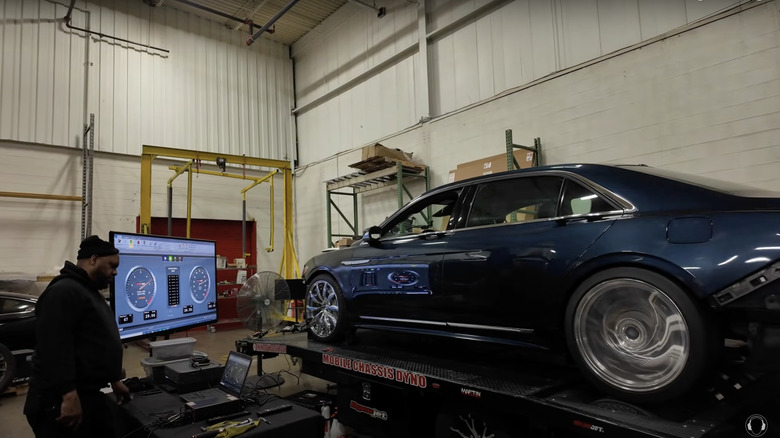Unless you can get your hands on one of the ultra-rare suicide-door examples, the tenth-generation Lincoln Continental was never a particularly cool car. Heck, even with the suicide doors, it’s really only cool to a small group of enthusiasts, and there’s a pretty good chance they won’t notice it driving down the road, either. A V8 swap might help, but if you’re already building your own, why not go one step further and give it a V10 instead?
Well, as our friends at the Build It Yourself channel found out the hard way, even with a shop and all the right tools, shoving a V10 in there is a lot harder than it may sound. For some reason, Ford’s engineers didn’t think to make room in the engine bay for the old gasoline V10 found in the F-250. Ridiculous, right? And yet, they soldiered on, and the result sounds so much better than you could have possibly imagined. Seriously.
They also used a few Mustang parts to make the Continental rear-wheel drive and gave it a manual transmission yanked from a GT500, because why not? Better is a matter of personal taste, but at the very least, those changes make it a much more interesting car. The question is, though, as awesome as this build is, how much power does it actually make? One month and one dyno visit later, we now have our answer.
Dyno testing the V10 Continental
While this generation of Continental never got anything bigger than a V6, its twin-turbo 3.0-liter V6 still made a healthy 400 horsepower and 400 pound-feet of torque. The V10 may not have any turbos, but it has four more cylinders and more than double the displacement, so, especially after all the other work they did, it shouldn’t have a problem besting the dinky little V6, right? Of course, at least when it comes to horsepower.
And it still sounds absolutely heavenly while doing it, too. Seriously, even if you don’t care about the power figures, just watch the video to listen to the glorious noises this thing makes. To do that, skip to about the 13-minute mark so you don’t miss them starting it up again.
For those of you who do care about power figures, as they state at about the 14-minute mark, the goal is 700 hp at the crank, but for the initial test, they said they’d be happy with 540 hp at the wheels. However, its first time on the rollers didn’t get anywhere close to that number. Instead, they only hit 448 hp at about 6,000 rpm and an undetermined amount of torque. On the second pull, they saw 453 hp and 397 lb-ft of torque. For the third pull, though, they were finally confident enough to push the RPMs north of 7,000 to really see what it could do. Turns out, that was 491 hp and 387 lb-ft. On the fourth and final run, they hit 494 hp and 391 lb-ft.
At the end, the official, presumably weather and altitude-adjusted, numbers came in a little higher than what was displayed on the screen during the actual dyno test — 496 hp and 402 lb-ft.
What’s next for the V10 Continental?
When you toss a build onto a dyno for the first time, especially one as complicated as this one, it’s a win if everything goes right and nothing blows up. So getting the engine up to nearly 7,800 rpm was a big accomplishment. Still, they aren’t done. To hit that goal of 700 hp at the crank, they’re going to have to get power at the wheels north of 550 hp. As they found during testing, though, their fuel pump and injectors didn’t appear to quite be up to the task past about 6,000 rpm.
As they point out, it wasn’t like they cheaped out on parts, and they’re open to the possibility there were other issues, like fuel, that caused power to flatline around 6,500 rpm. If they can figure out what’s going on, though, don’t be surprised if they end up hitting that (estimated) 700 hp figure. Even if they don’t, though, it’s hard to imagine anyone complaining about a V10 that revs past 7,700 rpm and makes nearly 500 hp at the wheels.
Of course, they also have to finish both the interior and the exterior, but that shouldn’t be too hard. At least not compared to building a 40-valve V10 that revs far higher than stock and shoving it into a rear-wheel-drive-converted Continental with a manual transmission.
While it isn’t the main point, it’s also crazy that their channel still hasn’t crossed the 100,000-subscriber mark. It won’t happen overnight, but let’s see if we can get their subscriber count a lot closer to six figures than it already is. I mean, they’re building a manual, V10, rear-wheel drive Lincoln Continental. If that isn’t worthy of more subscribers, I don’t know what is.




